Dr Fauci, gain-of-function, Human experimentation, laboratory leak, lung infection, virus research, Wuhan
Lance D Johnson and Tyler Durden
commentaries by Robert Gorter, MD, PhD.
(New book details Dr. Fauci’s involvement in Wuhan and the Chinese military’s dangerous gain-of-function coronavirus research with funding by the Pentagon through DARPA)
Bypass censorship by sharing this link:
https://www.afinalwarning.com/502991.html
March 14th, 2021
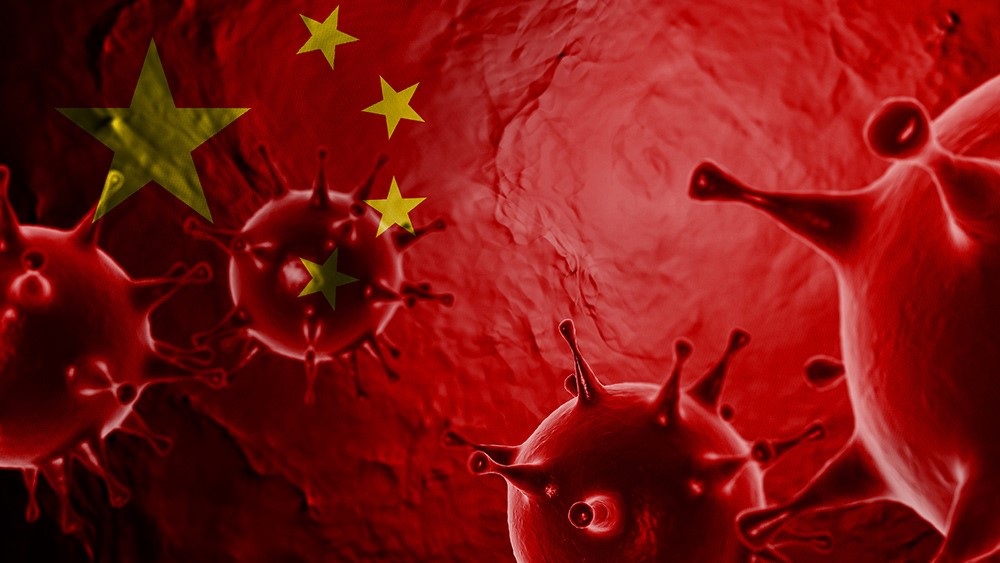
Image: New book details Dr. Fauci’s involvement in Wuhan and the Chinese military’s dangerous gain-of-function coronavirus research
Washington Post journalist Josh Rogin published a new book titled: “Chaos Under Heaven: Trump, Xi, and the Battle for the Twenty-First Century.”
The new book provides valuable intel on the origins of SARS CoV-2. China’s Wuhan Institute of Virology (WIV) is home to the world’s most unethical gain-of-function research on virus infectivity. Scientists at the WIV were modifying coronaviruses to understand how they can exploit human immune systems. The goal of the research was to come up with new vaccines in case an outbreak did occur. That unethical research on bat coronaviruses was funded by top scientists from the US government, Dr. Francis Collins and Dr. Anthony Fauci of the National Institutes of Health (NIH). The research was banned by the Obama Administration in October 2014, but was soon off-shored to China with grants coming from the NIH.
U.S. diplomats warned Washington about inadequate safety of Wuhan Institute of Virology already in 2018
Rogin reveals that the US Embassy in Beijing “took the unusual step of repeatedly sending US science diplomats to the WIV” in 2018 and sent two warnings back to Washington about the “inadequate safety of the lab.” The American diplomats were shocked that the lab “didn’t have enough properly trained technicians to safely operate their BSL-4 lab.” It’s no coincidence that a new coronavirus outbreak began in the exact same city that spent years studying coronavirus gain-of-function, with the largest collection of bat coronaviruses in the world, including the closest known relative of SARS-CoV-2!
In his brave pursuit for the truth, Rogin reveals in-depth insight from top U.S government officials who have evidence of dangerous Chinese gain of function research on coronaviruses that went above and beyond the gain-of-function research that was openly discussed with US universities and institutions. Rogin revels that Chinese researchers were taking more risks in the lab, risks that governments did not understand at the time. The Chinese scientists ultimately found a way to engineer coronavirus spike proteins to exploit the ACE2 receptor in human lung cells. (Related: China rewrites COVID history, purges 300 studies linking virus to Wuhan lab.)
Chinese military classified some of their most dangerous gain-of-function research
One of the more suspicious studies came from Beijing researchers affiliated with the Academy of Military Medical Science. In June 2020, the researchers published a new model for studying SARS-CoV-2, one that uses the CRISPR gene editing tool to alter mice lung cells. The scientists equipped the mice with the ACE2 receptor from human lung cells. This is the same receptor that they learned how to exploit with modified coronaviruses, using enhanced gain-of-function properties.
Upon further investigation, U.S. officials found evidence that this research was taking place in the lead-up to the original SARS-CoV-2 outbreak in China. The research was previously undisclosed and Chinese researchers continued to deny it was taking place. Before the Trump Administration left office, the State Department wrote in a January 15 2021 statement that the WIV had only disclosed some of its participation in gain-of-function research, but failed to disclose their work on RaTG13, which was classified laboratory animal experimentation, conducted on behalf of the Chinese military since 2017.
“This was just a peek under a curtain of an entire galaxy of activity, including labs and military labs in Beijing and Wuhan playing around with coronaviruses in ACE2 mice in unsafe labs,” a senior US official told Rogin. “It suggests we are getting a peek at a body of activity that isn’t understood in the West or even has precedent here.”
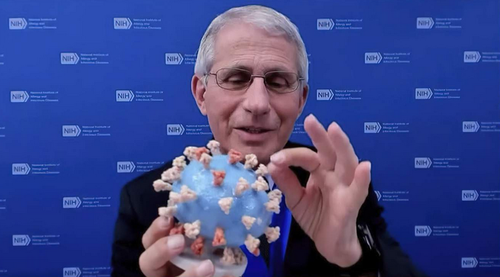
A Happy Dr. Anthony Fauci showing a model of the virus he co-sponsored by the NIH with tax–payers money through DARPA
Tyler Durden:
In April 2020, the Washington Post’s Josh Rogin revealed that in January 2018, the US Embassy in Beijing “took the unusual step of repeatedly sending US science diplomats to the Wuhan Institute of Virology (WIV),” and subsequently sent two official warnings back to Washington about “inadequate safety at the lab.”
The punchline has not changed; if one simply connects the dots and applies a modicum of logic, the fact that COVID-19 emerged “on the doorstep of the lab that possessed one of the world’s largest collections of bat coronaviruses and that possessed the closest known relative of SARS-CoV-2,” after years of performing so-called “gain-of-function” research modifying animal viruses to better infect humans (and which the Obama administration banned in October 2014 in the United States), and you have American diplomats reporting that they were “shocked” that Chinese researchers “didn’t have enough properly trained technicians to safely operate their BSL-4 lab,” and the likelihood of COVID-19 having escaped from WIV seems like a foregone conclusion.
Now, Rogin is out with a new book; “Chaos Under Heaven: Trump, Xi, and the Battle for the Twenty-First Century,” where he offers a 10,000-foot view of the evidence implicating the Wuhan Institute of Virology in the origins of the COVID-19 pandemic, while also confirming that the US National Institutes of Health (NIH) – headed by Dr. Anthony Fauci, “had funded a number of projects that involved WIV scientists, including much of the Wuhan lab’s work with bat coronaviruses.”

Wuhan military laboratory
The Wuhan Institute of Virology had openly participated in gain-of-function research in partnership with U.S. universities and institutions. But the official told me the U.S. government had evidence that Chinese labs were performing gain-of-function research on a much larger scale than was publicly disclosed, meaning they were taking more risks in more labs than anyone outside China was aware of. This insight, in turn, fed into the lab-accident hypothesis in a new and troubling way. -Josh Rogin book excerpt, via Politico
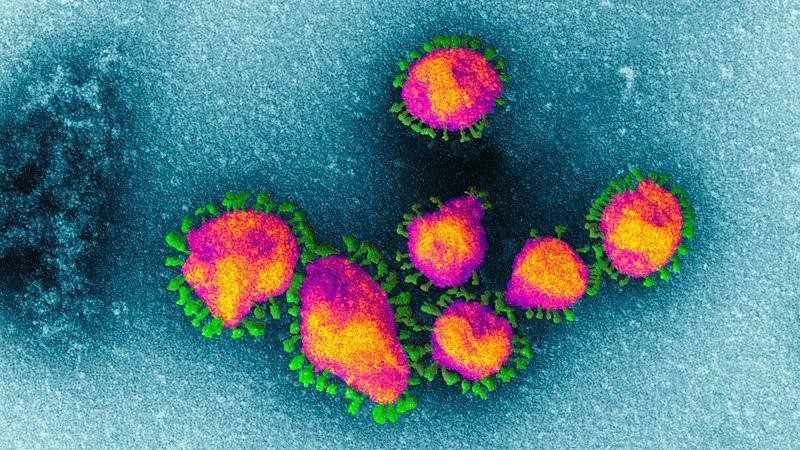
Rogin also notes that in July 2020, a little-noticed study by a group of Chinese researchers in Beijing, “including several affiliated with the Academy of Military Medical Science,” who said they had created a new model for studying SARS-CoV-2 “by creating mice with human-like lung characteristics by using the CRISPR gene-editing technology to give the mice lung cells with the human ACE2 receptor – the receptor that allowed coronaviruses to so easily infect human lungs.”
After consultations with experts, some U.S. officials came to believe this Beijing lab was likely conducting coronavirus experiments on mice fitted with ACE2 receptors well before the coronavirus outbreak—research they hadn’t disclosed and continued not to admit to. In its January 15, 2021, statement, the State Department alleged that although the Wuhan Institute of Virology disclosed some of its participation in gain-of-function research, it has not disclosed its work on RaTG13 and “has engaged in classified research, including laboratory animal experiments, on behalf of the Chinese military since at least 2017.” That, by itself, did not help to explain how SARS-CoV-2 originated. But it was clear that officials believed there was a lot of risky coronavirus research going on in Chinese labs that the rest of the world was simply not aware of. -Josh Rogin
“This was just a peek under a curtain of an entire galaxy of activity, including labs and military labs in Beijing and Wuhan playing around with coronaviruses in ACE2 mice in unsafe labs,” a senior US official told Rogin. “It suggests we are getting a peek at a body of activity that isn’t understood in the West or even has precedent here.”
As a result of China’s ‘pattern of deception and obfuscation,’ about their COVID research, some Trump administration officials became increasingly convinced that CCP officials were manipulating scientific data to fit their narrative. The problem, however, is that there was so little transparency from Beijing that it was impossible for US officials to prove whether SARS-CoV-2 came from a Chinese lab or not.
“If there was a smoking gun, the CCP (Communist Party of China) buried it along with anyone who would dare speak up about it,” a US official told Rogin. “We’ll probably never be able to prove it one way or the other, which was Beijing’s goal all along.”
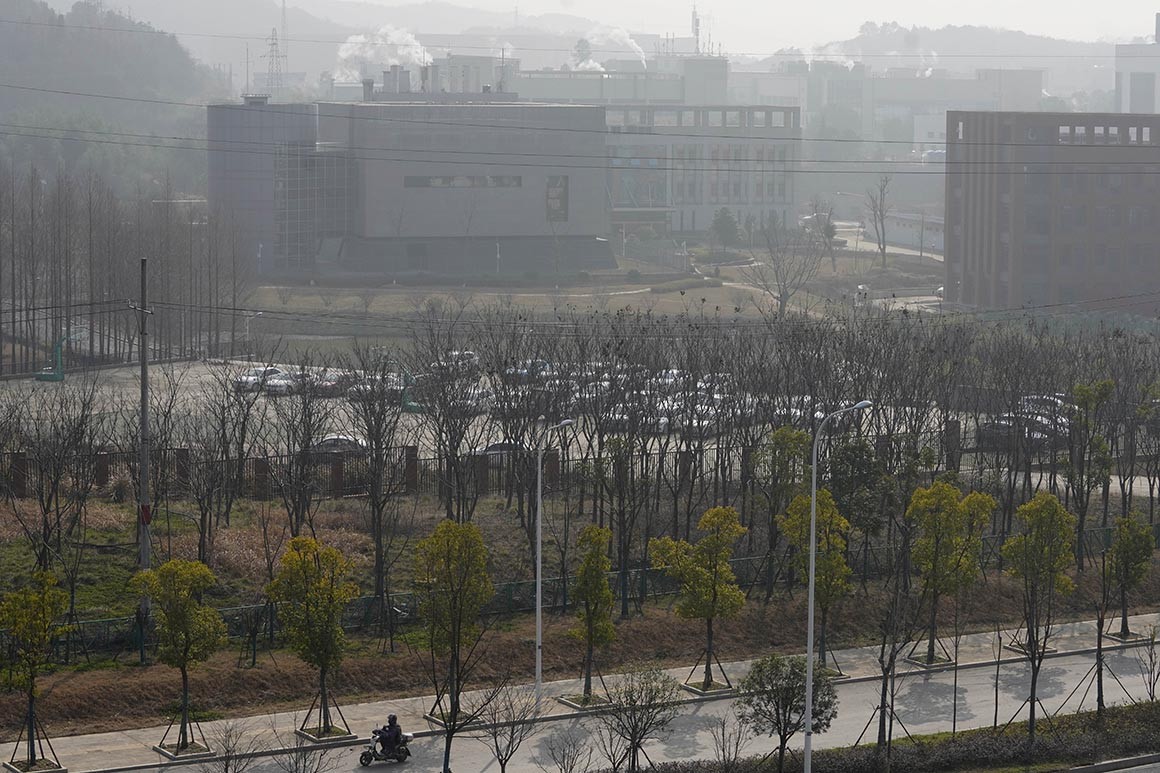
Military Laboratory in Wuhan
January 15, 2021, in its last days, President Donald Trump’s State Department put out a statement with serious claims about the origins of the Covid-19 pandemic. The statement said the U.S. intelligence community had evidence that several researchers at the Wuhan Institute of Virology laboratory were sick with Covid-like symptoms in autumn 2019—implying the Chinese government had hidden crucial information about the outbreak for months—and that the WIV lab, despite “presenting itself as a civilian institution,” was conducting secret research projects with the Chinese military. The State Department alleged a Chinese government cover-up and asserted that “Beijing continues today to withhold vital information that scientists need to protect the world from this deadly virus, and the next one.”
The exact origin of the new coronavirus remains a mystery to this day, but the search for answers is not just about assigning blame. Unless the source is located, the true path of the virus can’t be traced, and scientists can’t properly study the best ways to prevent future outbreaks.
The exact origin of the new coronavirus remains a mystery to this day, but the search for answers is not just about assigning blame. Unless the source is located, the true path of the virus can’t be traced, and scientists can’t properly study the best ways to prevent future outbreaks.
The original Chinese government story that the pandemic spread from a seafood market in Wuhan, was the first and therefore most widely accepted theory. But cracks in that theory slowly emerged throughout the late winter and spring of 2020. The first known case of Covid-19 in Wuhan was revealed in February and had no connection to the market. The Chinese government closed the market in January 2020 and sanitized it before proper samples could be taken. It wouldn’t be until May 2020 that the Chinese Centers for Disease Control disavowed the market theory, admitting it had no idea how the outbreak began, but by then it had become the story of record, in China and internationally.
In the spring of 2020, inside the U.S. government, some officials began to see and collect evidence of a different, perhaps more troubling theory—that the outbreak had a connection to one of the laboratories in Wuhan, among them the WIV, a world leading center of research on bat coronaviruses.
To some inside the government, the name of the laboratory was familiar. Its research on bat viruses had already drawn the attention of U.S. diplomats and officials at the Beijing Embassy in late 2017, prompting them to alert Washington that the lab’s own scientists had reported “a serious shortage of appropriately trained technicians and investigators needed to safely operate this high-containment laboratory.”
But their cables to Washington were ignored.
When I published the warnings from these cables in April 2020, they added fuel to a debate that had already gone from a scientific and forensic question to a hot-button political issue, as the previously internal U.S. government debate over the lab’s possible connection spilled into public view. The next day, Trump said he was “investigating,” and Secretary of State Mike Pompeo called on Beijing to “come clean” about the origin of the outbreak. Two weeks later, Pompeo said there was “enormous evidence” pointing to the lab, but he didn’t provide any of said evidence. As Trump and Chinese President Xi Jinping’s relationship unraveled and administration officials openly blamed the Wuhan lab, the U.S.-China relationship only went further downhill.
As the pandemic set in worldwide, the origin story was largely set aside in the public coverage of the crisis. But the internal government debate continued, now over whether the United States should release more information about what it knew about the lab and its possible connection to the outbreak. The January 15 statement was cleared by the intelligence community, but the underlying data was still held secret. Likely changing no minds, it was meant as a signal—showing that circumstantial evidence did exist, and that the theory deserved further investigation.
Now, the new Joe Biden team is walking a tightrope, calling on Beijing to release more data, while declining to endorse or dispute the Trump administration’s controversial claims. The origin story remains entangled both in domestic politics and U.S.-China relations. Last month, National security adviser Jake Sullivan issued a statement expressing “deep concerns” about a forthcoming report from a team assembled by the World Health Organization that toured Wuhan—even visiting the lab—but was denied crucial data by the Chinese authorities.
The original Chinese government story that the pandemic spread from a seafood market in Wuhan, was the first and therefore most widely accepted theory. But cracks in that theory slowly emerged throughout the late winter and spring of 2020. The first known case of Covid-19 in Wuhan, it was revealed in February, had no connection to the market. The Chinese government closed the market in January and sanitized it before proper samples could be taken. It wouldn’t be until May that the Chinese Centers for Disease Control disavowed the market theory, admitting it had no idea how the outbreak began, but by then it had become the story of record, in China and internationally.
In the spring of 2020, inside the U.S. government, some officials began to see and collect evidence of a different, perhaps more troubling theory—that the outbreak had a connection to one of the laboratories in Wuhan, among them the WIV, a world leading center of research on bat coronaviruses.
To some inside the government, the name of the laboratory was familiar. Its research on bat viruses had already drawn the attention of U.S. diplomats and officials at the Beijing Embassy in late 2017, prompting them to alert Washington that the lab’s own scientists had reported “a serious shortage of appropriately trained technicians and investigators needed to safely operate this high-containment laboratory.”
But their cables to Washington were ignored.
When I published the warnings from these cables in April 2020, they added fuel to a debate that had already gone from a scientific and forensic question to a hot-button political issue, as the previously internal U.S. government debate over the lab’s possible connection spilled into public view. The next day, Trump said he was “investigating,” and Secretary of State Mike Pompeo called on Beijing to “come clean” about the origin of the outbreak. Two weeks later, Pompeo said there was “enormous evidence” pointing to the lab, but he didn’t provide any of said evidence. As Trump and Chinese President Xi Jinping’s relationship unraveled and administration officials openly blamed the Wuhan lab, the U.S.-China relationship only went further downhill.
As the pandemic set in worldwide, the origin story was largely set aside in the public coverage of the crisis. But the internal government debate continued, now over whether the United States should release more information about what it knew about the lab and its possible connection to the outbreak. The January 15 statement was cleared by the intelligence community, but the underlying data was still held secret. Likely changing no minds, it was meant as a signal—showing that circumstantial evidence did exist, and that the theory deserved further investigation.
But more than four years ago, long before this question blew up into an international point of tension between China and the United States, the story started with a simple warning.
In late 2017, top health and science officials at the U.S. Embassy in Beijing attended a conference in the Chinese capital. There, they saw a presentation on a new study put out by a group of Chinese scientists, including several from the Wuhan lab, in conjunction with the U.S. National Institutes of Health and DARPA.
Since the 2002 outbreak of SARS—the deadly disease caused by a coronavirus transmitted by bats in China—scientists around the world had been looking for ways to predict and limit future outbreaks of similar diseases. To aid the effort, the NIH had funded a number of projects that involved the WIV scientists, including much of the Wuhan lab’s work with bat coronaviruses. The new study was entitled “Discovery of a Rich Gene Pool of Bat SARS-Related Coronaviruses Provides New Insights into the Origin of SARS Coronavirus.”
These researchers, the American officials learned, had found a population of bats from caves in Yunnan province that gave them insight into how SARS coronaviruses originated and spread. The researchers boasted that they may have found the cave where the original SARS coronavirus originated. But all the U.S. diplomats cared about was that these scientists had discovered three new viruses that had a unique characteristic: they contained a “spike protein” that was particularly good at grabbing on to a specific receptor in human lung cells known as an ACE2 receptor. That means the viruses were potentially very dangerous for humans—and that these viruses were now in a lab with which they, the U.S. diplomats, were largely unfamiliar.
Knowing the significance of the Wuhan virologists’ discovery, and knowing that the WIV’s top-level biosafety laboratory (BSL-4) was relatively new, the U.S. Embassy health and science officials in Beijing decided to go to Wuhan and check it out. In total, the embassy sent three teams of experts in late 2017 and early 2018 to meet with the WIV scientists, among them Shi Zhengli, often referred to as the “bat woman” because of her extensive experience studying coronaviruses found in bats.
When they sat down with the scientists at the WIV, the American diplomats were shocked by what they heard. The Chinese researchers told them they didn’t have enough properly trained technicians to safely operate their BSL-4 lab. The Wuhan scientists were asking for more support to get the lab up to top standards.
The diplomats wrote two cables to Washington reporting on their visits to the Wuhan lab. More should be done to help the lab meet top safety standards, they said, and they urged Washington to get on it. They also warned that the WIV researchers had found new bat coronaviruses could easily infect human cells, and which used the same cellular route that had been used by the original SARS coronavirus.
Taken together, those two points—a particularly dangerous groups of viruses being studied in a lab with real safety problems—were intended as a warning about a potential public-health crisis, one of the cable writers told me. They kept the cables unclassified because they wanted more people back home to be able to read and share them, according to the cable writer. But there was no response from State Department headquarters and they were never made public. And as U.S.-China tensions rose over the course of 2018, American diplomats lost access to labs such as the one at the WIV.
“The cable was a warning shot,” one U.S. official said. “They were begging people to pay attention to what was going on.” The world would be paying attention soon enough—but by then, it would be too late.
The cables were not leaked to me by any Trump administration political official, as many in the media wrongly assumed. In fact, Secretary of State Pompeo was angry when he found out about the leak. He needed to keep up the veneer of good relations with China, and these revelations would make that job more difficult. Trump and President Xi had agreed during their March 26 phone call to halt the war of words that had erupted when a Chinese diplomat alleged on Twitter that the outbreak might have been caused by the U.S. Army. That had prompted Trump to start calling it the “China virus,” deliberately blaming Beijing in a racist way. Xi had warned Trump in that call that China’s level of cooperation on releasing critical equipment in America’s darkest moment would be jeopardized by continued accusations.
After receiving the cables from a source, I called around to get reactions from other American officials I trusted. What I found was that, just months into the pandemic, a large swath of the government already believed the virus had escaped from the WIV lab, rather than having leaped from an animal to a human at the Wuhan seafood market or some other random natural setting, as the Chinese government had claimed.
Any theory of the pandemic’s origins had to account for the fact that the outbreak of the novel coronavirus—or, by its official name, SARS-CoV-2—first appeared in Wuhan, on the doorstep of the lab that possessed one of the world’s largest collections of bat coronaviruses and that possessed the closest known relative of SARS-CoV-2, a virus known as RaTG13 that Shi identified in her lab.
Shi, in her March interview, said that when she was first told about the virus outbreak in her town, she thought the officials had gotten it wrong, because she would have guessed that such a virus would break out in southern China, where most of the bats live. “I had never expected this kind of thing to happen in Wuhan, in central China,” she said.
By April 2020, U.S. officials at the NSC and the State Department had begun to compile circumstantial evidence that the WIV lab, rather than the seafood market, was actually the source of the virus. The former explanation for the outbreak was entirely plausible, they felt, whereas the latter would be an extreme coincidence. But the officials couldn’t say that out loud because there wasn’t firm proof either way. And if the U.S. government accused China of lying about the outbreak without firm evidence, Beijing would surely escalate tensions even more, which meant that Americans might not get the medical supplies that were desperately needed to combat the rapid spread of SARS-CoV-2 in the United States.
Arkansas Senator Tom Cotton seemed not to have been concerned about any of those considerations. On February 16, he had offered a totally unfounded theory of his own, claiming on Fox News that the virus might have come from China’s bio-warfare program—suggesting, in other words, that it had been engineered deliberately to kill humans. This wasn’t supported by any known research: To this day, scientists largely agree that the virus was not “engineered” to be deadly; SARS-CoV-2 showed no evidence of direct genetic manipulation. Furthermore, the WIV lab had published some of its research about bat coronaviruses that can infect humans—not exactly the level of secrecy you would expect for a clandestine weapons program.

What is DARPA? How does DARPA introduces itself online?
For sixty years, DARPA has held to a singular and enduring mission: to make pivotal investments in breakthrough technologies for national security.
The genesis of that mission and of DARPA itself dates to the launch of Sputnik in 1957, and a commitment by the United States that, from that time forward, it would be the initiator and not the victim of strategic technological surprises. Working with innovators inside and outside of government, DARPA has repeatedly delivered on that mission, transforming revolutionary concepts and even seeming impossibilities into practical capabilities. The ultimate results have included not only game-changing military capabilities such as precision weapons and stealth technology, but also such icons of modern civilian society such as the Internet, automated voice recognition and language translation, and Global Positioning System receivers small enough to embed in myriad consumer devices.
DARPA explicitly reaches for transformational change instead of incremental advances. But it does not perform its engineering alchemy in isolation. It works within an innovation ecosystem that includes academic, corporate and governmental partners, with a constant focus on the Nation’s military Services, which work with DARPA to create new strategic opportunities and novel tactical options. For decades, this vibrant, interlocking ecosystem of diverse collaborators has proven to be a nurturing environment for the intense creativity that DARPA is designed to cultivate.
DARPA comprises approximately 620 government employees in six technical offices, including nearly 100 program managers, who together oversee about 450 research and development programs: both domestic and international programs.
DARPA goes to great lengths to identify, recruit and support excellent program managers—extraordinary individuals who are at the top of their fields and are hungry for the opportunity to push the limits of their disciplines. These leaders, who are at the very heart of DARPA’s history of success, come from academia, industry and government agencies for limited stints, generally three to five years. That deadline fuels the signature DARPA urgency to achieve success in less time than might be considered reasonable in a conventional setting.
Program managers address challenges broadly, spanning the spectrum from deep science to systems to capabilities, but ultimately they are driven by the desire to make a difference. They define their programs, set milestones, meet with their performers and assiduously track progress. But they are also constantly probing for the next big thing in their fields, communicating with leaders in the scientific and engineering community to identify new challenges and potential solutions.
Program managers report to DARPA’s office directors and their deputies, who are responsible for charting their offices’ technical directions, hiring program managers and overseeing program execution. The technical staff is also supported by experts in security, legal and contracting issues, finance, human resources and communications. These are the people who make it possible for program managers to achieve big things during their relatively short tenures.
At the Agency level, the DARPA Director and Deputy Director approve each new program and review ongoing programs, while setting Agency-wide priorities and ensuring a balanced investment portfolio.
DARPA benefits greatly from special statutory hiring authorities and alternative contracting vehicles that allow the Agency to take quick advantage of opportunities to advance its mission. These legislated capabilities have helped DARPA continue to execute its mission effectively.
DARPA as very close ties with the Pentagon
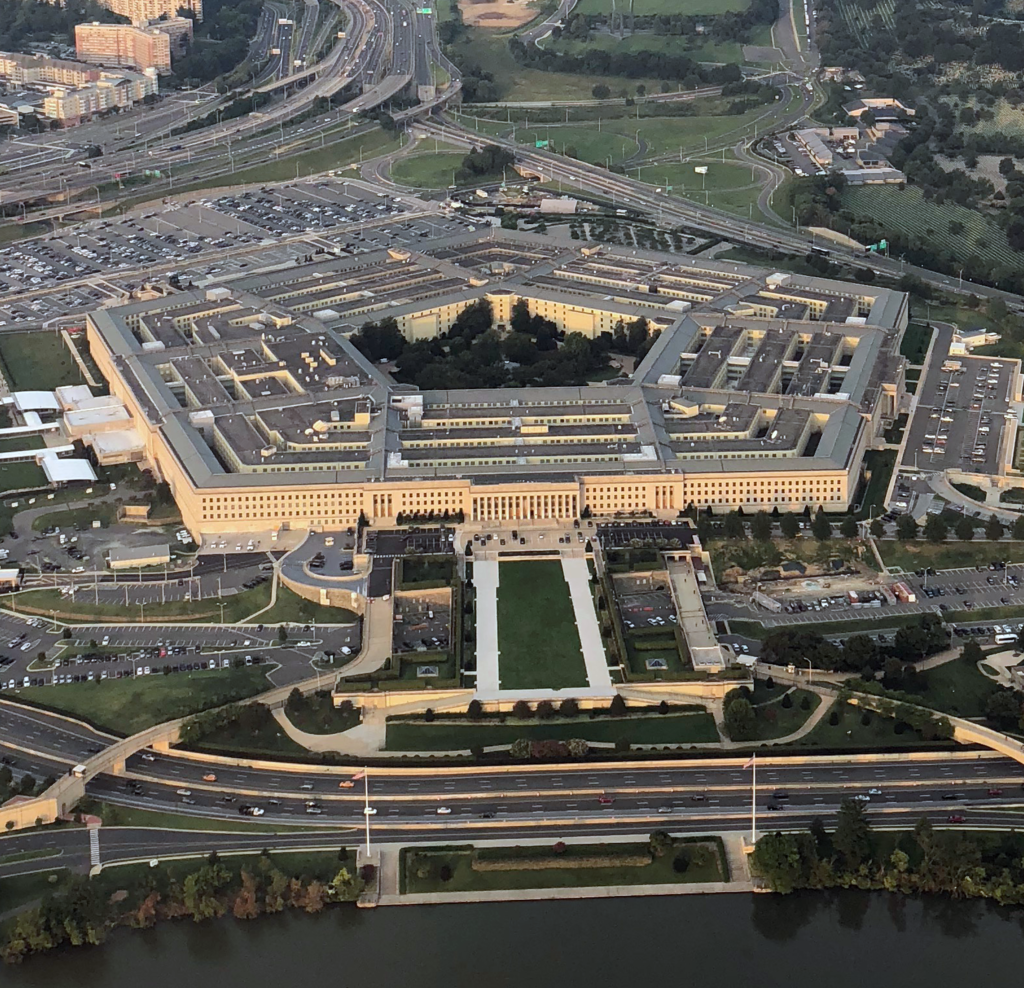
What is the Pentagon?
The Pentagon is the headquarters building of the United States Department of Defense. As a symbol of the U.S. military, the phrase The Pentagon is also often used as a metonym or synecdoche for the Department of Defense and its leadership.
The Pentagon is the world’s largest office building, with about 6,500,000 square feet (150 acres; 0.60 km2) of floor space, of which 3,700,000 sq ft (85 acres; 0.34 km2) are used as offices. Some 23,000 military and civilian employees and another 3,000 non-defense support personnel, work in the Pentagon. It has five sides, five floors above ground, two basement levels, and five ring corridors per floor with a total of 17.5 miles (28.2 km) of corridors. The central five-acre (2.0 ha) pentagonal plaza is nicknamed “ground zero” on the presumption that it would be a prime target in a nuclear war.
On 11 September 2001, American Airlines Flight 77 was hijacked and flown into the western side of the building, killing 189 people. Of those killed, 64 were on the hijacked airplane, and 125 were in the Pentagon. It was the first significant foreign attack on Washington’s governmental facilities since the city was burned by the British during the War of 1812.
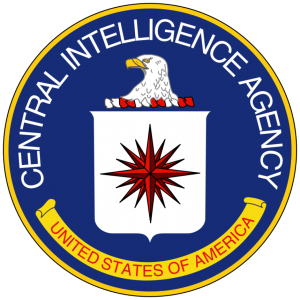
What is the CIA?
The Central Intelligence Agency (CIA), known informally as “The Agency” and “The Company”, is a civilian foreign intelligence service of the federal government of the United States, officially tasked with gathering, processing, and analyzing national security information from around the world, primarily through the use of human intelligence (HUMINT). As a principal member of the United States Intelligence Community (IC), the CIA reports to the Director of National Intelligence and is primarily focused on providing intelligence for the President and Cabinet of the United States.
Unlike the Federal Bureau of Investigation (FBI), which is a domestic security service, the CIA has no law enforcement function and is officially mainly focused on overseas intelligence gathering, with only limited domestic intelligence collection. The CIA serves as the national manager for coordination of HUMINT activities across the U.S. intelligence community. It is the only agency authorized by law to carry out and oversee covert action at the behest of the President. It exerts foreign political influence through its tactical divisions, such as the Special Activities Center. The CIA was also instrumental in establishing intelligence services in several U.S. allied countries, such as Germany’s BND. It has also provided support to many foreign political groups and governments, including planning, coordinating, training on torture, technical support, and was involved in several regime changes, terrorist attacks and planned assassinations of foreign leaders.
Since 2004, the CIA is organized under the Director of National Intelligence (DNI). Despite transferring some of its powers to the DNI, the CIA has grown in size as a response to the September 11 attacks. In 2013, The Washington Post reported that in the fiscal year 2010, the CIA had the largest budget of all IC agencies, exceeding previous estimates.
The CIA has increasingly expanded its role, including covert paramilitary operations. One of its largest divisions, the Information Operations Center (IOC), has officially shifted focus from counter-terrorism to offensive cyber-operations.
The agency has been the subject of many controversies; including human rights violations, domestic wiretapping and propaganda, and allegations of drug trafficking and overthrowing foreign governments (Chili, Libya, Iran, Iraq, etc.). It has also appeared in works of fiction, including books, films and video games.
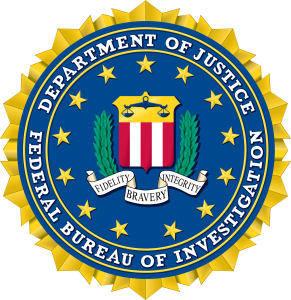
What is the FBI?
The Federal Bureau of Investigation (FBI) is the domestic intelligence and security service of the United States and its principal federal law enforcement agency. Operating under the jurisdiction of the United States Department of Justice, the FBI is also a member of the U.S. Intelligence Community and reports to both the Attorney General and the Director of National Intelligence. A leading U.S. counter-terrorism, counterintelligence, and criminal investigative organization, the FBI has jurisdiction over violations of more than 200 categories of federal crimes.
Although many of the FBI’s functions are unique, its activities in support of national security are comparable to those of the British MI5 and the Russian FSB. Unlike the Central Intelligence Agency (CIA), which has no law enforcement authority and is focused on intelligence collection abroad, the FBI is primarily a domestic agency, maintaining 56 field offices in major cities throughout the United States, and more than 400 resident agencies in smaller cities and areas across the nation. At an FBI field office, a senior-level FBI officer concurrently serves as the representative of the Director of National Intelligence.
Despite its domestic focus, the FBI also maintains a significant international footprint, operating 60 Legal Attache (LEGAT) offices and 15 sub-offices in U.S. embassies and consulates across the globe. These foreign offices exist primarily for the purpose of coordination with foreign security services and do not usually conduct unilateral operations in the host countries. The FBI can and does at times carry out secret activities overseas, just as the CIA has a limited domestic function; these activities generally require coordination across government agencies.
The FBI was established in 1908 as the Bureau of Investigation, the BOI or BI for short. Its name was changed to the Federal Bureau of Investigation (FBI) in 1935. The FBI headquarters is the J. Edgar Hoover Building, located in Washington, D.C.